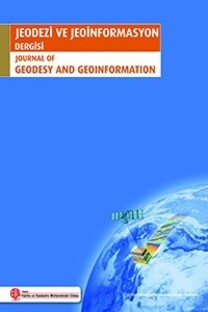Jeodezik ağlarda kaba hatanın bilinmeyen olarak modellenmesi
Uyuşumsuz ölçülerin tespitinde sıklıkla kullanılan Baarda ve Pope yöntemlerinde kaba hatalar toplam yanlılık (additive bias) modeliyle kestirilmektedir. Geleneksel yöntemin aksine uyuşumsuz ölçüler ek bilinmeyen olarak modellenebilmektedir. Bu yaklaşımda bütün ölçülere kuşkulu bakılmaktadır. Bu nedenle olası bütün kombinasyonların hesaba katılması önem arz etmektedir. Ağdaki ölçü sayısı kadar (n elemanlı) kümeden meydana gelmesi muhtemel en yüksek kaba hata sayısına kadar olan kombinasyonların değerlendirilmesi temeline dayanmaktadır. Bu çalışmanın amacı, kaba hatanın bilinmeyen olarak modellenmesi yaklaşımını jeodezik ağlarda uygulamak ve farklı dağılımlara ait karşılaştırma değerleriyle elde edilen sonuçların güvenirliğini değerlendirmektir. Geleneksel ve önerilen yaklaşımların gizleme ve batma etkisi senaryolarında da etkinlikleri araştırılmıştır. Bu amaçla; bir jeodezik nivelman ağı simüle edilerek küçük genlikli kaba hataların tespit edilmesine ait ortalama başarı oranları hesaplanmıştır. Elde edilen sonuçlara göre kaba hatanın bilinmeyen olarak modellenmesi yaklaşımı geleneksel yöntemlere nazaran yaklaşık %30-40 daha güvenilirdir. Önerilen yöntemde kullanılan üç farklı dağılımdan standart normal dağılım ve Tau dağılımı en yüksek başarı oranına sahiptir. Bununla beraber gizleme ve batma etkisi senaryolarında hem geleneksel hem de önerilen yaklaşıma ait sonuçların yanıltıcı olduğu gözlenmiştir.
Anahtar Kelimeler:
Kaba Hata, Bilinmeyen parametrelerin modellemesi, Güvenirlik, Test istatistiği
Modeling outliers as unknown in geodetic networks
In the Baarda and Pope methods, frequently used to detect outliers, the total bias additive model estimates the outliers. Unlike the traditional method, outliers can be modeled as additional unknowns. With this approach, all observations are viewed as suspicion. It is, therefore, essential to consider all possible combinations. It is based on evaluating the combinations from the number of observations in the network (n elements) to the highest possible number of outliers that can occur. This study aims to apply the approach of modeling the outliers as unknown in the geodetic network and to evaluate the results' reliability with the comparison values from different distributions. Also, the effectiveness of traditional and proposed approach in the masking and swamping effect scenarios were investigated. For this purpose, mean success rates for detecting small magnitude outliers were calculated by simulating a geodetic leveling network. According to the results, modeling the outliers as unknown is approximately 30-40% more reliable than traditional methods. Among the three distributions used in the proposed method, the standard normal distribution and Tau distribution have the highest success rates. Additionally, it has been noticed that both the conventional and proposed methods produce misleading outcomes in cases involving swamping and masking effects.
Keywords:
Outlier, Modelling of unknown parameters, Reliability, Test statistics,
___
- Baarda, W. (1968). A testing procedure for use in geodetic networks. Netherlands geodetic commission, 2(5).
- Baselga, S. (2007). Critical limitation in use of τ test for gross error detection. Journal of Surveying Engineering, 133(2), 52-55.
- Cook, R. D., & Weisberg, S. (1982). Residuals and influence in regression. New York: Chapman and Hall.
- Demirel, H. (2003). Dengeleme hesabı. İstanbul: Yıldız Teknik Üniversitesi Basım-Yayım Merkezi.
- Durdağ, U. M., Hekimoğlu, Ş., & Erdoğan, B. (2022). What is the relation between smearing effect of least squares estimation and its influence function?. Survey Review, 54(385), 320-331.
- Erdoğan, B., Hekimoğlu, Ş., Durdağ, U. M., & Öcalan, T. (2019). Empirical estimation of the power of test in outlier detection problem. Studia Geophysica et Geodaetica, 63, 55-70.
- Gauss, C. F. (1823). Theoria combinationis observationum erroribus minimis obnoxiae. Göttingen: Henricus Dieterich.
- Grossmann, W. (1969). Grundzüge der Ausgleichungsrechnung. Berlin: Springer.
- Hadi, A. S., & Simonoff, J. S. (1993). Procedures for the identification of multiple outliers in linear models. Journal of the American statistical association, 88(424), 1264-1272.
- Hampel, F. R. (1968). Contributions to the theory of robust estimation. Berkeley: University of California.
- Hampel, F. R., Ronchetti, E., Rousseeuw, P. J., & Stahel, W. A. (1986). Robust statistics: the approach based on influence functions. New York: John Wiley & Sons.
- Hekimoğlu, Ş., & Koch, K. R. (2000). How can reliability of the test for outliers be measured. Allg. Vermes. Nachr, 107(7), 247-254.
- Hekimoğlu, Ş. (2006). Kaba hataların belirlenmesindeki sorunlar. Harita Dergisi, 73(135), 80 – 93.
- Hekimoğlu, Ş., & Erenoğlu, R. C. (2007). Effect of heteroscedasticity and heterogeneousness on outlier detection for geodetic networks. Journal of Geodesy, 81, 137-148.
- Hekimoğlu, Ş., Erdoğan, B., Soycan, M., & Durdağ, U. M. (2014). Univariate approach for detecting outliers in geodetic networks. Journal of surveying engineering, 140(2), 04014006.
- Hekimoğlu, S., Erdoğan, B., & Erenoğlu, R. C. (2015). A new outlier detection method considering outliers as model errors. Experimental Techniques, 39, 57-68.
- Koch, K. R. (1999). Parameter estimation and hypothesis testing in linear models. Berlin: Springer.
- Kreyszig, E. (1968). Statistische Methoden und ihre Anwendungen, 3., Göttingen: durchgesehene Auf.
- Markov, A. A. (1912). Wahrscheinlichkeitsrechnung. Leipzig: BG Teubner.
- Maronna, R. A., Martin, R. D., & Yohai, V. J. (2006). Robust statistics theory and methods. New York: John Wiley & Sons.
- Niemeier, W. (1985). “Anlage von Überwachungsnetzen.” Geodaetische netze in landes-und ingenieurvermessung II., H. Pelzer, ed., (pp: 527–558). Stuttgart: Verlag Konrad Wittwer.
- Pope, A. J. 1976. The statistics of residuals and the detection of outlierss (No. NOS-65-NGS-1).
- Rousseeuw, P. J., & Leroy, A. M. (1987). Robust regression and outlier detection. New York: Wiley.
- Schaffrin, B., & Wang, Z. W. (1994). Multiplicative outlier search using homBLUP and an equivalence theorem. manuscripta geodaetica, 20(1), 21-26.
- Welsch, W., Heunecke, O., & Kuhlmann, H. (2000). Handbuch Ingenieurgeodäsie. Auswertung geodätischer Uberwachungsmessungen, 3. Berlin: Wichmann.
- Xu, P. (2005). Sign-constrained robust least squares, subjective breakdown point and the effect of weights of observations on robustness. Journal of Geodesy, 79(1-3), 146-159.
- ISSN: 2147-1339
- Yayın Aralığı: Yılda 2 Sayı
- Başlangıç: 2012
- Yayıncı: TMMOB Harita ve Kadastro Mühendisleri Odası
Sayıdaki Diğer Makaleler
Türkiye kadastrosunda güncelleme çalışmaları sırasında karşılaşılan problemler ve çözüm önerileri
Duygu ARICAN, Ferat Furkan GÖKSU, Nursu TUNALIOĞLU, Taylan ÖCALAN
Jeodezik ağlarda kaba hatanın bilinmeyen olarak modellenmesi
Suç olaylarının CBS ile analizi ve görselleştirilmesi: Suçun kalıplarını ve dağılımını anlamak
